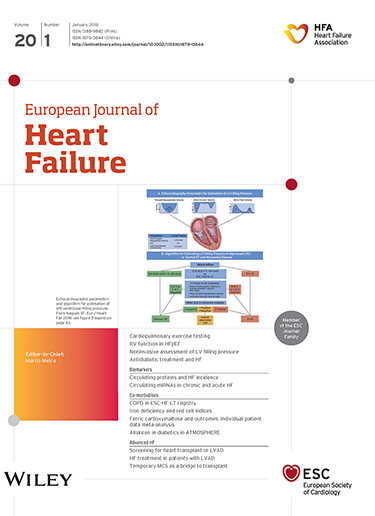Interplay of serum potassium and kidney function with finerenone in heart failure with mildly reduced or preserved ejection fraction: Findings from FINEARTS-HF.
IF 10.8
1区 医学
Q1 CARDIAC & CARDIOVASCULAR SYSTEMS
引用次数: 0
Abstract
AIMS Finerenone improved heart failure (HF) outcomes in patients with heart failure and mildly reduced or preserved ejection fraction (HFmrEF/HFpEF). Clinical decision-making around initiation of mineralocorticoid receptor antagonists often relies on measures of kidney function and serum potassium (K+) levels. The aim of this study was to evaluate the efficacy and safety of finerenone across categories of serum K+ and estimated glomerular filtration rate (eGFR). METHODS AND RESULTS Four mutually exclusive categories were created: (1) K+ ≤4.5 mmol/L and eGFR ≥60 ml/min/1.73 m2; (2) K+ >4.5 mmol/L and eGFR ≥60 ml/min/1.73 m2; (3) K+ ≤4.5 mmol/L and eGFR <60 ml/min/1.73 m2; and (4) K+ >4.5 mmol/L and eGFR <60 ml/min/1.73 m2. Outcomes and treatment effects were compared across these categories. The primary outcome was a composite of total HF events and cardiovascular death. The median follow-up was 32 months. A total of 6001 patients were included. Compared to patients with K+ ≤4.5 mmol/L and eGFR ≥60 ml/min/1.73 m2, those with eGFR <60 ml/min/1.73 m2, irrespective of K+ levels, had a 1.5- to 2-fold higher risk of experiencing primary outcome and fatal events across treatment groups. No significant interaction was observed on the effects of finerenone (vs. placebo) on the primary outcome across K+/eGFR categories. The respective risk ratios (RR) and 95% confidence intervals (CI) were: (1) K+ ≤4.5 mmol/L and eGFR ≥60 ml/min/1.73 m2: RR 0.66, 95% CI 0.52-0.85; (2) K+ >4.5 mmol/L and eGFR ≥60 ml/min/1.73 m2: RR 0.92, 95% CI 0.65-1.30; (3) K+ ≤4.5 mmol/L and eGFR <60 ml/min/1.73 m2: RR 0.91, 95% CI 0.74-1.13; (4) K+ >4.5 mmol/L and eGFR <60 ml/min/1.73 m2: RR 0.92, 95% CI 0.72-1.17; p for interaction = 0.20. Patients with low eGFR and/or high K+ experienced more frequent adverse events and treatment discontinuation; still, categories of K+/eGFR did not significantly modify the relative risk of adverse events with finerenone versus placebo (p for interaction > 0.1 for all adverse events). CONCLUSIONS No significant heterogeneity was found on the effect of finerenone to reduce primary outcome events. Still, adverse events and treatment discontinuation were more frequent among patients with low eGFR and/or high K+, suggesting. that such patients may require tailored strategies to mitigate adverse events and avoid treatment discontinuation.血清钾和肾功能与细烯酮在心力衰竭伴轻度射血分数降低或保留的相互作用:finhearts - hf研究结果
目的:芬纳酮改善心力衰竭患者的心力衰竭(HF)结果,并轻度降低或保留射血分数(HFmrEF/HFpEF)。矿皮质激素受体拮抗剂启动的临床决策通常依赖于肾功能和血清钾(K+)水平的测量。本研究的目的是评估芬烯酮在血清K+和估计肾小球滤过率(eGFR)类别中的有效性和安全性。方法与结果建立4个互斥分类:(1)K+≤4.5 mmol/L, eGFR≥60 ml/min/1.73 m2;(2) K+ >4.5 mmol/L, eGFR≥60 ml/min/1.73 m2;(3) K+≤4.5 mmol/L, eGFR为4.5 mmol/L, eGFR为4.5 mmol/L, eGFR≥60 ml/min/1.73 m2: RR 0.92, 95% CI 0.65 ~ 1.30;(3) K+≤4.5 mmol/L, eGFR为4.5 mmol/L, eGFR为0.1)。结论芬尼酮对减少主要结局事件的影响无显著异质性。尽管如此,不良事件和治疗中断在低eGFR和/或高K+患者中更常见,这表明。这些患者可能需要量身定制的策略来减轻不良事件并避免停止治疗。
本文章由计算机程序翻译,如有差异,请以英文原文为准。
求助全文
约1分钟内获得全文
求助全文
来源期刊

European Journal of Heart Failure
医学-心血管系统
CiteScore
27.30
自引率
11.50%
发文量
365
审稿时长
1 months
期刊介绍:
European Journal of Heart Failure is an international journal dedicated to advancing knowledge in the field of heart failure management. The journal publishes reviews and editorials aimed at improving understanding, prevention, investigation, and treatment of heart failure. It covers various disciplines such as molecular and cellular biology, pathology, physiology, electrophysiology, pharmacology, clinical sciences, social sciences, and population sciences. The journal welcomes submissions of manuscripts on basic, clinical, and population sciences, as well as original contributions on nursing, care of the elderly, primary care, health economics, and other related specialist fields. It is published monthly and has a readership that includes cardiologists, emergency room physicians, intensivists, internists, general physicians, cardiac nurses, diabetologists, epidemiologists, basic scientists focusing on cardiovascular research, and those working in rehabilitation. The journal is abstracted and indexed in various databases such as Academic Search, Embase, MEDLINE/PubMed, and Science Citation Index.
 求助内容:
求助内容: 应助结果提醒方式:
应助结果提醒方式:


